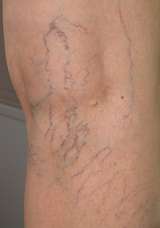Spider Veins
Find your care
We offer a full range of vein treatments, including ones developed at UCLA Health. Call 310-206-6294 to learn more about our services.
What are Spider Veins?
Spider veins are small, thin yet unsightly clusters of red, blue or purple veins that most commonly appear on the thighs, calves and ankles. Spider veins are mild varicose veins.
Known in the medical world as telangiectasias, these veins lie close to the surface of the skin. Although these super-fine veins are connected with the larger venous system, they are not an essential part of it. A number of factors contribute to the development of spider veins, including:

- Heredity
- Pregnancy
- Weight gain
- Occupations or activities that require prolonged sitting or standing
- The use of certain medications that cause hormonal shifts
Spider veins usually take on one of three basic patterns:
- They may appear in a true spider shape with a group of veins radiating outward from a dark central point
- They may be arborizing and will resemble tiny branch-like shapes
- They may be simply linear and appear as thin separate lines
Linear spider veins are commonly seen on the inner knee, whereas the arborizing pattern often appears on the outer thigh in a sunburst or cartwheel distribution.
Contact us to schedule an appointment.